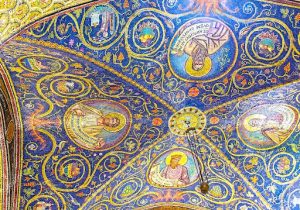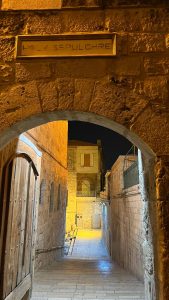If we enter the Basilica of the Holy Sepulcher in Jerusalem and turn to the right, we ascend a steep staircase to Calvary, the site of the Crucifixion. There, to the right, we find a Catholic chapel, and if we look up at the ceiling, we discover a mosaic depicting four prophecies that speak to us about the Passion of the Messiah: Daniel 9:26; Isaiah 53:7-9; Psalm 22; and Zechariah 12:10. Even today, rereading these texts and meditating on them while looking at the place where, according to tradition, the Cross of our Redeemer was raised, remains a deeply moving experience. That is why we will take a brief journey through these prophecies.

Chapel of the Holy Sepulcher, Jerusalem
The prophecy of Daniel 9:26, written in the 2nd century B.C., predicts the exact moment when the events concerning the Messiah would unfold. This passage indicates that after sixty-two weeks, the Messiah would be killed. It is interpreted that this period of time coincides with the appearance of Jesus Christ, whose crucifixion fulfills this prophecy. The subsequent destruction of the city and the temple is linked to the fall of Jerusalem in the year 70 A.D., an event that some interpret as symbolic of the end of the Jewish sacrificial system, as it is replaced by the sacrifice of Christ.
Isaiah 53:7-9 vividly describes the suffering of the Messiah, highlighting His voluntary sacrifice and His suffering without objection. This passage is fulfilled in Jesus Christ, who, during His trial and crucifixion, offered no resistance, accepting His suffering in silence. It also emphasizes the Messiah’s innocence and the absence of deceit—qualities attributed to Jesus Christ, who lived without sin and was declared innocent by Pilate.

Entrance to the Holy Sepulcher, Jerusalem
Finally, the prophecy of Zechariah 12:10 foretells the outpouring of the Holy Spirit, the recognition of the pierced Messiah, and the mourning over Him. This passage is interpreted in a messianic sense, linking it to the crucifixion of Jesus Christ and the later repentance of those who wounded Him. It also alludes to the suffering of Mary, the mother of Jesus, who was present at the crucifixion.
Taken together, these biblical prophecies offer a profound and moving vision of the events surrounding the crucifixion of Jesus Christ. Meditating on these prophecies while contemplating the physical site of the crucifixion provides a tangible connection to Christian history and faith.
By D. Rafael Sanz Carrera, priest.
